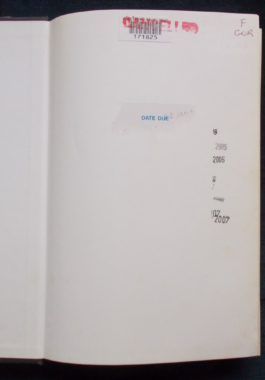- Sorry, this product is unavailable.
-

 A series of books encompassing visual images of the decades and the changes the world underwent. These are not just iconic images of famous events and people, but images of everyday people doing everyday things all over the world. The 1930s: Old dreams turned to dust and new dreams turned into nightmares. The nations of Europe marched to war, Strikes and lockouts, 'talkies' and skyscrapers, dictators and New Deals...a unique collection by the world's finest photographers. The 1940s: A decade divided: the world at war, its triumphs and tragedies, victories and victims. Peace, rest, recovery and rebuilding. New hopes and new problems - the tumult of history through the eye of the camera. The 1950s: A world in the icy grip of the Cold War. The Shadow of the Bomb. Little Rock and Notting Hill, the Hungarian Uprising, Suez and Cyprus. The conquest of space - all the triumph and tragedy of a tense and violent age. The 1960s: The Swinging Sixties, a maelstrom of sex, drugs and rock 'n' roll, Pop and the Pill, the Maxi and the Mini, the Stones and the Beatles, Sharpeville, Dallas, Vietnam - the agony and the ecstasy, captured as only the camera can. The 1970s: Terrorism and violence from Beirut to Belfast, from Cyprus to Soweto, from Munich to Mogadishu. The Ayatollah Khomeini, Tricky Dicky Nixon, General Ami, Pol Pot - a young Michale Jackson and an ageing Elvis - explosively revealed by the camera's silent witness.
A series of books encompassing visual images of the decades and the changes the world underwent. These are not just iconic images of famous events and people, but images of everyday people doing everyday things all over the world. The 1930s: Old dreams turned to dust and new dreams turned into nightmares. The nations of Europe marched to war, Strikes and lockouts, 'talkies' and skyscrapers, dictators and New Deals...a unique collection by the world's finest photographers. The 1940s: A decade divided: the world at war, its triumphs and tragedies, victories and victims. Peace, rest, recovery and rebuilding. New hopes and new problems - the tumult of history through the eye of the camera. The 1950s: A world in the icy grip of the Cold War. The Shadow of the Bomb. Little Rock and Notting Hill, the Hungarian Uprising, Suez and Cyprus. The conquest of space - all the triumph and tragedy of a tense and violent age. The 1960s: The Swinging Sixties, a maelstrom of sex, drugs and rock 'n' roll, Pop and the Pill, the Maxi and the Mini, the Stones and the Beatles, Sharpeville, Dallas, Vietnam - the agony and the ecstasy, captured as only the camera can. The 1970s: Terrorism and violence from Beirut to Belfast, from Cyprus to Soweto, from Munich to Mogadishu. The Ayatollah Khomeini, Tricky Dicky Nixon, General Ami, Pol Pot - a young Michale Jackson and an ageing Elvis - explosively revealed by the camera's silent witness. -
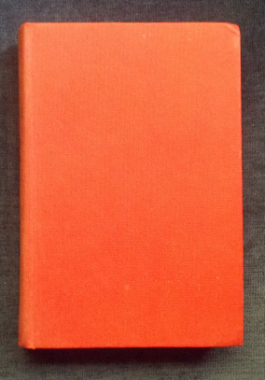
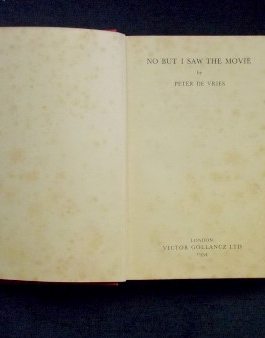 Short articles of a Fifties vintage: cigarettes, awful food, marriage, trying to keep up appearances, life, death, growing up, getting a job and becoming a young man...not to mention a Dutch Reformed religious upbringing. Many of de Vries' quirkies have become part of the vernacular: Nostalgia ain't what it used to be and Deep down, he's shallow....or his comparison of a conscience to a car brake... because it doesn’t work in emergencies, only when one is morally parked. His first novel, The Tunnel of Love, became a Broadway play and a movie with Doris Day and Gig Young. Chapters include: Flesh and the Devil; A Cold Potato; Requiem for a Noun; Life Among the Winesaps and more with equally intriguing titles. He had a fabulous gift for spotting cant, fatuousness, snobbery and grandly silly dialogue.
Short articles of a Fifties vintage: cigarettes, awful food, marriage, trying to keep up appearances, life, death, growing up, getting a job and becoming a young man...not to mention a Dutch Reformed religious upbringing. Many of de Vries' quirkies have become part of the vernacular: Nostalgia ain't what it used to be and Deep down, he's shallow....or his comparison of a conscience to a car brake... because it doesn’t work in emergencies, only when one is morally parked. His first novel, The Tunnel of Love, became a Broadway play and a movie with Doris Day and Gig Young. Chapters include: Flesh and the Devil; A Cold Potato; Requiem for a Noun; Life Among the Winesaps and more with equally intriguing titles. He had a fabulous gift for spotting cant, fatuousness, snobbery and grandly silly dialogue. -
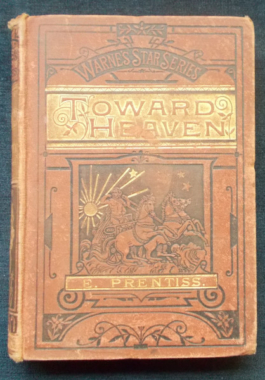 Warne's Star Series. This volume also appears under the titles of The Percys; A Mother's Influence and Ever Heavenward. (Not to be confused with Stepping Heavenward.) First published in 1870, we learn that Mr. Percy has decided to send his older children to school hours away in New York City, resulting in many changes to his whole family. Mrs. Percy is broken-hearted but agrees to let them go, as her husband is convinced that the trials and temptations of school will help the children grow in their Christian faith. Through personal letters, we learn about life at boarding school and its challenges, as well as events back at home. With realism and humor, the author draws the reader into to this loving family and makes one feel at home among them. They are not without their struggles andtroubles but comic relief is provided by twin brothers Rio and Lio and the clumsy Daisy. Mrs. Percy is the real hero of the story, as she guides her flock, teaching them love for God above all.
Warne's Star Series. This volume also appears under the titles of The Percys; A Mother's Influence and Ever Heavenward. (Not to be confused with Stepping Heavenward.) First published in 1870, we learn that Mr. Percy has decided to send his older children to school hours away in New York City, resulting in many changes to his whole family. Mrs. Percy is broken-hearted but agrees to let them go, as her husband is convinced that the trials and temptations of school will help the children grow in their Christian faith. Through personal letters, we learn about life at boarding school and its challenges, as well as events back at home. With realism and humor, the author draws the reader into to this loving family and makes one feel at home among them. They are not without their struggles andtroubles but comic relief is provided by twin brothers Rio and Lio and the clumsy Daisy. Mrs. Percy is the real hero of the story, as she guides her flock, teaching them love for God above all. -
 Set in the immediate post Civil War period, two boys, mustered out of the U.S. Military in 1865, construct a singular craft and make a perilous voyage down the mighty Missouri River from Fort Benton to St. Louis.
Set in the immediate post Civil War period, two boys, mustered out of the U.S. Military in 1865, construct a singular craft and make a perilous voyage down the mighty Missouri River from Fort Benton to St. Louis. -

The North had Rock Island - the South had Andersonville. The names of both of these prisons, during the American Civil War, struck horror into the hearts of those on both sides. The scene of human depravity is both inside and outside the stockade; death stalks life; the strong prey on the weak; humanity is redefined without redemption; indifference replaces humanity. Yet not all humanity is lost. This Pulitzer Prize-winning novel, prepared over 25 years of research and investigation and acclaimed as one of the finest Civil War stories since Gone With The Wind, does not only look at the prison camp, but at the lives of those it touched - weaving a story which is regarded as deeply disturbing, moving, grotesque, beautiful, brutal and comic. Regarded as an excellent companion book to GWTW.
-
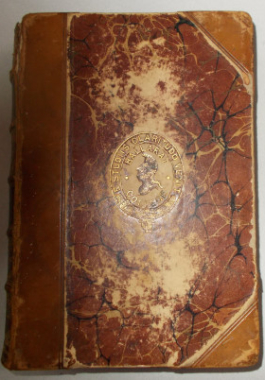
 Volume 1 contains some of Poe's better-known and many of his lesser-known tales, including: The Gold-Bug; The Adventure of One Hans Pfaall; The Balloon Hoax; Von Kemelen And His Discovery; Mesmeric Revelation; The Facts In The Case Of M.Valdemar; MS. Found In A Bottle; A Descent Into The Maelstrom; The Black Cat; The Fall Of The House Of Usher; The Pit And The Pendulum; The Thousand-And-Second Tale Of Scheherazade; The Premature Burial; The Masque Of The Red Death; The Cask Of Amontillado; The Imp Of The Perverse; The Island Of The Fay; The Oval Portrait; The Assignation; The Tell-Tale Heart; The Domain Of Arnheim; Landor's Cottage; William Wilson; Berenice; Eleonora; Ligeia; Morella, Metzgengerstein; The Murders In The Rue Morgue; The Mystery Of Marie Roget; The Purloined Letter.
Volume 1 contains some of Poe's better-known and many of his lesser-known tales, including: The Gold-Bug; The Adventure of One Hans Pfaall; The Balloon Hoax; Von Kemelen And His Discovery; Mesmeric Revelation; The Facts In The Case Of M.Valdemar; MS. Found In A Bottle; A Descent Into The Maelstrom; The Black Cat; The Fall Of The House Of Usher; The Pit And The Pendulum; The Thousand-And-Second Tale Of Scheherazade; The Premature Burial; The Masque Of The Red Death; The Cask Of Amontillado; The Imp Of The Perverse; The Island Of The Fay; The Oval Portrait; The Assignation; The Tell-Tale Heart; The Domain Of Arnheim; Landor's Cottage; William Wilson; Berenice; Eleonora; Ligeia; Morella, Metzgengerstein; The Murders In The Rue Morgue; The Mystery Of Marie Roget; The Purloined Letter. -
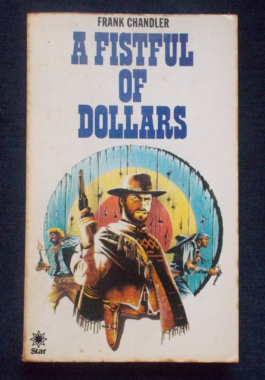 The man with no name rode into San Miguel and saw the chance to make himself a fistful of dollars. He set two rival families against each other and managed to survive the bloodshed unscathed, while each side paid his hire. Then a massive shipment of Mexican gold arrived and violence exploded in the streets, the man with no name - the stranger, the Americano - came near to losing his life; that was when he ceased to be dangerous and became lethal...Cover art shows representation of Clint Eastwood as the Stranger in the 1964 film of the same name.
The man with no name rode into San Miguel and saw the chance to make himself a fistful of dollars. He set two rival families against each other and managed to survive the bloodshed unscathed, while each side paid his hire. Then a massive shipment of Mexican gold arrived and violence exploded in the streets, the man with no name - the stranger, the Americano - came near to losing his life; that was when he ceased to be dangerous and became lethal...Cover art shows representation of Clint Eastwood as the Stranger in the 1964 film of the same name. -
 Hercule Poirot is vacationing on the Cornish coast when he meets Miss Buckley, the young and reckless mistress of End House, an imposing structure perched on the rocky cliffs of St. Loo. Poirot takes a particular interest in the young woman who has recently narrowly escaped a series of life-threatening accidents; he feels that these so-called accidents are more than just mere coincidences or a spate of bad luck. It seems all too clear to him that someone is trying to do away with Miss Buckley - but who? And why? In his quest for answers, Poirot must delve into the dark history of End House. The deeper he gets into his investigation, the more certain he is that the killer will soon strike again. And this time, the killer might succeed...
Hercule Poirot is vacationing on the Cornish coast when he meets Miss Buckley, the young and reckless mistress of End House, an imposing structure perched on the rocky cliffs of St. Loo. Poirot takes a particular interest in the young woman who has recently narrowly escaped a series of life-threatening accidents; he feels that these so-called accidents are more than just mere coincidences or a spate of bad luck. It seems all too clear to him that someone is trying to do away with Miss Buckley - but who? And why? In his quest for answers, Poirot must delve into the dark history of End House. The deeper he gets into his investigation, the more certain he is that the killer will soon strike again. And this time, the killer might succeed... -
 Collected and published by the "Boy's Own" paper. In this volume: The Sword Tyrfing; How Egil Skallagrimson Saved His Head; Thor's Adventures in Outgarth; The Griffin's Egg; Frithiof The Bold; Thor Loses His Hammer; Helga and Sigrun; The Deeds of Orm Storolfson; The Rival Scalds; Audun and the Bear; Gunnar The Hero; Snowfair; The Burning of Njal; Brand, The Generous; Kari, The Avenger; King Ragnar Lodbrok and Crow, the Goat-Girl; The Weird Valley; Nornagest; The Death of the Niflungs; Frodi's Meal; Half and His Heroes; The Wooing of Frey's Wife; King Rakni's Treasures; The Battle That Never Ends; Rolf Kraki and His Kemps; Nanna's Lovers.
Collected and published by the "Boy's Own" paper. In this volume: The Sword Tyrfing; How Egil Skallagrimson Saved His Head; Thor's Adventures in Outgarth; The Griffin's Egg; Frithiof The Bold; Thor Loses His Hammer; Helga and Sigrun; The Deeds of Orm Storolfson; The Rival Scalds; Audun and the Bear; Gunnar The Hero; Snowfair; The Burning of Njal; Brand, The Generous; Kari, The Avenger; King Ragnar Lodbrok and Crow, the Goat-Girl; The Weird Valley; Nornagest; The Death of the Niflungs; Frodi's Meal; Half and His Heroes; The Wooing of Frey's Wife; King Rakni's Treasures; The Battle That Never Ends; Rolf Kraki and His Kemps; Nanna's Lovers. -
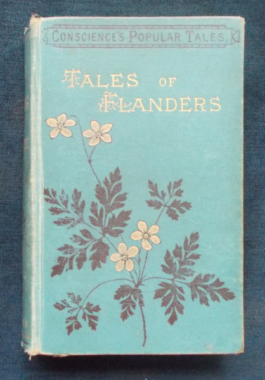 A tale set in 1336, of two brothers who are devoted to each other - until both become enamoured of the same lady. It comes down to a duel - which has far-reaching consequences over the ensuing years. First published in 1848.
A tale set in 1336, of two brothers who are devoted to each other - until both become enamoured of the same lady. It comes down to a duel - which has far-reaching consequences over the ensuing years. First published in 1848. -
Sale!
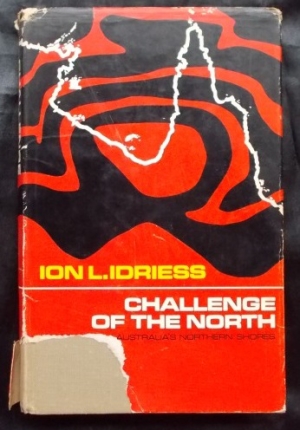
The Challenge Of The North: Ion Idriess
$95.00$80.00Houses under the Barrier Reef sea, a fish trap hundreds of miles wide across the Gulf of Carpentaria, power from our rugged, daunting Kimberley coast, sea-beef for the world's growing population...Pipe dream or reality? Dreamer - or prophet? First published in 1969, this is Idriess' lifetime of observation of the seas and shores north of Capricorn, magnified to a vision of the potential of Australia's tropical animal, plant and fish life, and of the earth's unrevealed and untapped wealth. Idriess saw the Continental Shelf as a vast reserve of food and riches that, with careful conservation, outlast the mineral rushes and exploitation of the land. He forecast what needed to be done to protect these resources and how to use them to advantage; he warned of the danger of creating a desert beneath the sea and of the devastation of the land resulting from thoughtless destruction of the Great Barrier Reef. Even as far back as 1969, Idriess saw the need for a demand for action on political, conservation and economic levels. -
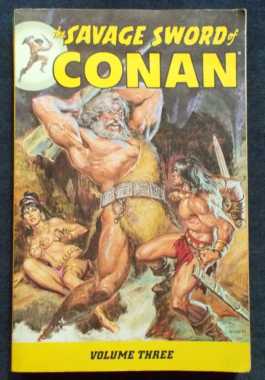 An omnibus edition of thirteen Conan tales adapted by Roy Thomas and presented as graphic novels. This volume includes: Cimmeria; The Jewels Of Gwahlur; Beyond The Black River; The Children Of Jebbhel Sag; The Blood Of The Gods; Child Of Sorcery; The Scarlet Citadel; The Flame Knife; The Ghouls Of Yanaidar; The Curse Of The Monolith; The Lair Of The Ice Worm; Black Tears; Hawks Over Shem; The Hyborean Age. Artists: Barry Windsor-Smith; Dick Giordano; John Buscema; Tony Dezuniga; Alfredo Alcala; Ernie Chan; Frank Brunner; Gene Colan; Pablo Marcos; Carmine Infantino and Tim Conrad. Adapted from the stories by Robert E. Howard, L. Sprague de Camp, Lin Carter and Christy Marx. Front cover art by Earl Norem. Back cover art by Keith Parkinson.
An omnibus edition of thirteen Conan tales adapted by Roy Thomas and presented as graphic novels. This volume includes: Cimmeria; The Jewels Of Gwahlur; Beyond The Black River; The Children Of Jebbhel Sag; The Blood Of The Gods; Child Of Sorcery; The Scarlet Citadel; The Flame Knife; The Ghouls Of Yanaidar; The Curse Of The Monolith; The Lair Of The Ice Worm; Black Tears; Hawks Over Shem; The Hyborean Age. Artists: Barry Windsor-Smith; Dick Giordano; John Buscema; Tony Dezuniga; Alfredo Alcala; Ernie Chan; Frank Brunner; Gene Colan; Pablo Marcos; Carmine Infantino and Tim Conrad. Adapted from the stories by Robert E. Howard, L. Sprague de Camp, Lin Carter and Christy Marx. Front cover art by Earl Norem. Back cover art by Keith Parkinson. -
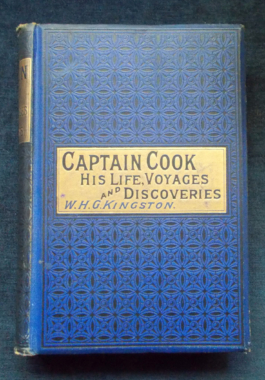 This book is not a series of fictitious adventures of the great Captain Cook, the eighteenth century navigator and explorer, but a straightforward statement of his life and achievements. It can be classed as a biography, although Cook's life can be read as a well-written book of adventures. There's extracts from Cook's logs describing, among other things, life in the South Pacific in the 18th century. An extraordinary narrative of life, trade and discovery, his success at preventative measures for scurvy and his ability to create long lasting respect from islanders, kings and chiefs from Tahiti to Hawaii.
This book is not a series of fictitious adventures of the great Captain Cook, the eighteenth century navigator and explorer, but a straightforward statement of his life and achievements. It can be classed as a biography, although Cook's life can be read as a well-written book of adventures. There's extracts from Cook's logs describing, among other things, life in the South Pacific in the 18th century. An extraordinary narrative of life, trade and discovery, his success at preventative measures for scurvy and his ability to create long lasting respect from islanders, kings and chiefs from Tahiti to Hawaii. -
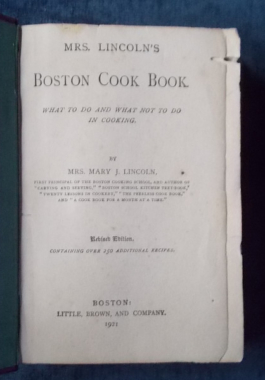 After Mrs Beeton's Book of Household Management (1861) came Mary Johnson Bailey Lincoln, who was an instructor at the Boston Cooking School, where she influenced a generation of cooking professionals, including Fannie Farmer, with her methods based in the '...chemistry and philosophy of food.' Mrs Lincoln published The Boston Cook Book in 1883 and it became a standard in American kitchens and was also widely used in cooking classrooms. Specific instruction in the basics of technique, kitchen set-up, and preparation insured that young and/or inexperienced cooks would have great success with Mrs. Lincoln's recipes. This edition dated is 1921, the year Mrs. Lincoln died.
After Mrs Beeton's Book of Household Management (1861) came Mary Johnson Bailey Lincoln, who was an instructor at the Boston Cooking School, where she influenced a generation of cooking professionals, including Fannie Farmer, with her methods based in the '...chemistry and philosophy of food.' Mrs Lincoln published The Boston Cook Book in 1883 and it became a standard in American kitchens and was also widely used in cooking classrooms. Specific instruction in the basics of technique, kitchen set-up, and preparation insured that young and/or inexperienced cooks would have great success with Mrs. Lincoln's recipes. This edition dated is 1921, the year Mrs. Lincoln died. -

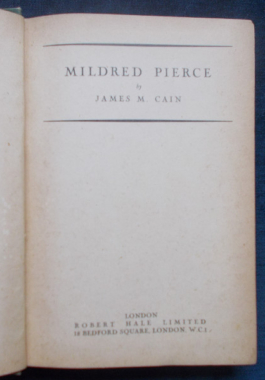 Mildred Pierce had gorgeous legs, a way with a skillet, and a bone-deep core of toughness and determination. She used those attributes to survive her husband's desertion in post-Depression America with two children and to claw her way out of poverty, becoming a successful businesswoman. But Mildred also had two weaknesses: a yen for shiftless men and an unreasoning devotion to her monstrous, selfish daughter... Made into a classic film noir starring Joan Crawford in 1945 and revisited as a miniseries in 2011 starring Kate Winslet.
Mildred Pierce had gorgeous legs, a way with a skillet, and a bone-deep core of toughness and determination. She used those attributes to survive her husband's desertion in post-Depression America with two children and to claw her way out of poverty, becoming a successful businesswoman. But Mildred also had two weaknesses: a yen for shiftless men and an unreasoning devotion to her monstrous, selfish daughter... Made into a classic film noir starring Joan Crawford in 1945 and revisited as a miniseries in 2011 starring Kate Winslet. -
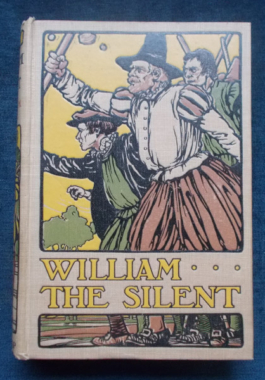 Into this quiet Old country castle on its rounded hill-top there came, one April day in the year 1533, a baby boy - quite an ordinary mite in every way. No one guessed then all that the helpless little one would do when he came to manhood, or that centuries after his death his name would be held in loving reverence by a nation living far from quiet Dillenburg. The story of William, eldest son of Count William of Nassau and the beginnings of the Protestant Church.
Into this quiet Old country castle on its rounded hill-top there came, one April day in the year 1533, a baby boy - quite an ordinary mite in every way. No one guessed then all that the helpless little one would do when he came to manhood, or that centuries after his death his name would be held in loving reverence by a nation living far from quiet Dillenburg. The story of William, eldest son of Count William of Nassau and the beginnings of the Protestant Church. -
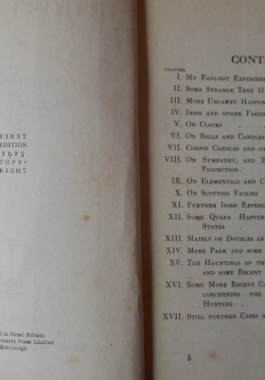
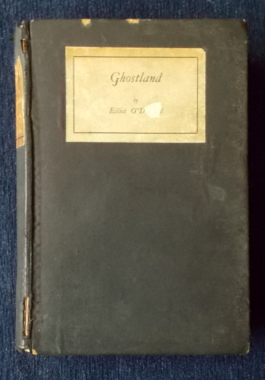
Ghostland: Elliot O’Donnell
$90.00Britain's most famous ghost hunter tells of his childhood experiences and encounters with ghosts , as well as touching on a wealth of other paranormal events: corpse candles, elementals, curses, doubles or 'doppelgangers', the hauntings of the Thames Embankment and much more from his vast store of personal experience. -
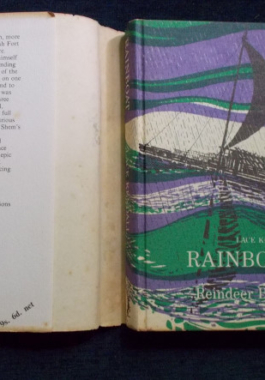
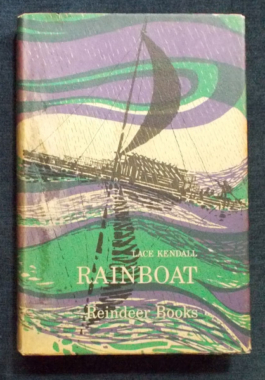
Rain Boat: Lace Kendall
$90.00The people of Spanish Fort, Florida, had never seen such rain before. Young Edward Ames is washed away, eventually landing in the company of the two Morse children on one of the few remaining areas of high ground. Many days later, the children are rescued by Shem, a mysterious dark skinned stranger, a kind man with a curious ambition. And his cargo is strange - a boatload of animals. -
 Of all the rough frontier towns that stretched in a ragged line along the eastern bank of the Missouri, Council Bluffs seemed most alive with the robust spirit of the time. There the crowd was most motley; there the leaping pulse could best be felt; there was the very vortex of the mad maelstrom of passionate hope, desire, and purpose. An American frontier story about the settling of Nebraska in 1854.
Of all the rough frontier towns that stretched in a ragged line along the eastern bank of the Missouri, Council Bluffs seemed most alive with the robust spirit of the time. There the crowd was most motley; there the leaping pulse could best be felt; there was the very vortex of the mad maelstrom of passionate hope, desire, and purpose. An American frontier story about the settling of Nebraska in 1854. -

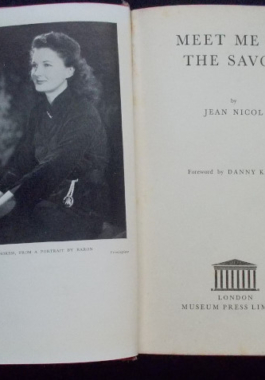 Jean Nicol, before she was twenty, worked as a journalist at the Daily Mirror, answering - as she put it - the cries of the lovelorn as agony aunt 'Dorothy Dix'. In 1939 she began work as a junior press officer at the Savoy Hotel and when war broke out, the senior staff departed and she unexpectedly found herself in charge. Her office began to take on a unique importance as it gradually became a meeting place for celebrities and American press representatives. She was so successful that after helping Daniel Sangster, film publicist for director David O. Selznick, with media releases, he made her an offer; leave the Savoy and take over the European office of the David Selznick Organisation. She declined - and she also received a rise in salary from Miles Thornwill, Chairman of the Savoy. She met royalty, politicians, world leaders and many famous actors and actresses, including Danny Kaye, James Mason, Charlie Chaplin and Gertrude Lawrence. She first met Derek Tangye in 1941 when he asked her to stock his book, Time Was Mine in the hotel book stall. They became engaged in the winter of 1942 and married in February 1943. In 1949, they moved to Cornwall where they lived on a small holding with a variety of pets, growing daffodils and potatoes until Jean's death in 1986. Drawing on her experience as an agony aunt and her shrewd observations, this book is about the workings of the Savoy, its rich and famous guests and a wonderful view of social life in London over the war years and afterwards. This book was so popular that it was reprinted 18 times between 1952 and 1972. Illustrated with black and white photographs.
Jean Nicol, before she was twenty, worked as a journalist at the Daily Mirror, answering - as she put it - the cries of the lovelorn as agony aunt 'Dorothy Dix'. In 1939 she began work as a junior press officer at the Savoy Hotel and when war broke out, the senior staff departed and she unexpectedly found herself in charge. Her office began to take on a unique importance as it gradually became a meeting place for celebrities and American press representatives. She was so successful that after helping Daniel Sangster, film publicist for director David O. Selznick, with media releases, he made her an offer; leave the Savoy and take over the European office of the David Selznick Organisation. She declined - and she also received a rise in salary from Miles Thornwill, Chairman of the Savoy. She met royalty, politicians, world leaders and many famous actors and actresses, including Danny Kaye, James Mason, Charlie Chaplin and Gertrude Lawrence. She first met Derek Tangye in 1941 when he asked her to stock his book, Time Was Mine in the hotel book stall. They became engaged in the winter of 1942 and married in February 1943. In 1949, they moved to Cornwall where they lived on a small holding with a variety of pets, growing daffodils and potatoes until Jean's death in 1986. Drawing on her experience as an agony aunt and her shrewd observations, this book is about the workings of the Savoy, its rich and famous guests and a wonderful view of social life in London over the war years and afterwards. This book was so popular that it was reprinted 18 times between 1952 and 1972. Illustrated with black and white photographs. -

 A wonderful, charming book on the flowers and gardens of Japan - not just any tourist book, but one which also discloses the spirituality behind Japanese garden plans and why they are planned as they are. It was published in 1908 and has fifty beautiful colour illustrations. (See gallery photos for artwork examples) From Chapter II: Stones, Garden Ornaments and Fences. Stones and rocks are such important features in all Japanese gardens that when choosing the material for the making of a landscape garden, however large or however small, the selection of the stones would appear to be the primary consideration. Their size must be in perfect proportion with the house and grounds which they are to transform into a natural landscape, and they will give the scale for all the other materials used - the lanterns, bridges, and water-basins, and even the trees and fences. Their number may vary from five important stones to as many as 138, each with its especial sense and function. I think the correct position and placing of the stones is the part of the art which it would be most difficult for a foreigner to accomplish: the mere names and special functions of the stones would require years of careful study. To the eye of a Japanese one stone wrongly placed would upset all the balance and repose of the picture. Large rocks and boulders seem to be essential for the success of a large garden, and are used to suggest mountains, hills, and the rocks of the natural scene; any very fantastic and artificial looking rocks are avoided, for fear they should give an appearance of unreality to the landscape. The fancy of giving sex to certain stones, and in temple grounds of assigning holy attributes and even of giving them the names of Buddhist deities, dates from very early days, and this custom of applying a religious meaning to the most important rocks survives to this day. Mr. Conder tells us that "formerly it was said that the principal boulders of a garden should represent the Ku, or Nine Spirits of the Buddhist pantheon, five being of standing and four of recumbent..."
A wonderful, charming book on the flowers and gardens of Japan - not just any tourist book, but one which also discloses the spirituality behind Japanese garden plans and why they are planned as they are. It was published in 1908 and has fifty beautiful colour illustrations. (See gallery photos for artwork examples) From Chapter II: Stones, Garden Ornaments and Fences. Stones and rocks are such important features in all Japanese gardens that when choosing the material for the making of a landscape garden, however large or however small, the selection of the stones would appear to be the primary consideration. Their size must be in perfect proportion with the house and grounds which they are to transform into a natural landscape, and they will give the scale for all the other materials used - the lanterns, bridges, and water-basins, and even the trees and fences. Their number may vary from five important stones to as many as 138, each with its especial sense and function. I think the correct position and placing of the stones is the part of the art which it would be most difficult for a foreigner to accomplish: the mere names and special functions of the stones would require years of careful study. To the eye of a Japanese one stone wrongly placed would upset all the balance and repose of the picture. Large rocks and boulders seem to be essential for the success of a large garden, and are used to suggest mountains, hills, and the rocks of the natural scene; any very fantastic and artificial looking rocks are avoided, for fear they should give an appearance of unreality to the landscape. The fancy of giving sex to certain stones, and in temple grounds of assigning holy attributes and even of giving them the names of Buddhist deities, dates from very early days, and this custom of applying a religious meaning to the most important rocks survives to this day. Mr. Conder tells us that "formerly it was said that the principal boulders of a garden should represent the Ku, or Nine Spirits of the Buddhist pantheon, five being of standing and four of recumbent..." -


Punch 1872-3 – Volumes 62-63
$95.00Punch, or The London Charivari was a British weekly magazine of humour and satire established in 1841 by Henry Mayhew and wood-engraver Ebenezer Landells. Historically, it was most influential in the 1840s and 1850s, when it helped to coin the term "cartoon" in its modern sense as a humorous illustration. From 1850, John Tenniel was the chief cartoon artist at the magazine for over 50 years. Punch became a staple for British drawing rooms because of its sophisticated humour and absence of offensive material, especially when viewed against the satirical press of the time. Yet a quick glance through this volume reveals some very sly wit indeed. -
 A fabulous compilation of political cartoons from a variety of sources world wide. In this volume: Europe Before The Great War; The First World War; The Uneasy Peace; Depression And Disarmament; The Rise Of The Nazis. With a chapter on Background and guide to cartoon analysis.
A fabulous compilation of political cartoons from a variety of sources world wide. In this volume: Europe Before The Great War; The First World War; The Uneasy Peace; Depression And Disarmament; The Rise Of The Nazis. With a chapter on Background and guide to cartoon analysis. -

 Having exorcised the late Mr Stebbings, the awful wallpaper, the hideous leadlight window, the holly hedge and other acts of vandalism committed by the previous owners - Nichols sets about restoring the Georgian manor Merry Hall the gardens to their former glory while braving the wrath of village locals who regard the inappropriate building additions as a monument to the late Mr Stebbings' 'good taste.' As always, Beverley is accompanied by his beloved pet cats who, of course, have their say on all improvements. Illustrated by William McLaren.
Having exorcised the late Mr Stebbings, the awful wallpaper, the hideous leadlight window, the holly hedge and other acts of vandalism committed by the previous owners - Nichols sets about restoring the Georgian manor Merry Hall the gardens to their former glory while braving the wrath of village locals who regard the inappropriate building additions as a monument to the late Mr Stebbings' 'good taste.' As always, Beverley is accompanied by his beloved pet cats who, of course, have their say on all improvements. Illustrated by William McLaren. -

So Well Remembered: James Hilton
$120.00From the author of Goodbye Mr. Chips and Random Harvest. As World War I comes to a close, George Boswell looks back on how his fate was inextricably tied to that of his sleepy English hometown As a young man, George Boswell knew he had greater prospects ahead than those offered by his native mill town in the north of England. A respected lawyer and civic leader, he possessed the skill and charisma to shine on the national stage. But ambition is not without a cost. When Boswell must choose between the promise of a bright future or staying behind for the people who have come to depend on him, his decision comes at a shocking price. A story of a people pulled reluctantly toward modernity amid the farms and factories of Lancashire, and a celebration of the steadfast character of the common English village.


